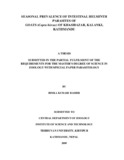Please use this identifier to cite or link to this item:
https://elibrary.tucl.edu.np/handle/123456789/3538Full metadata record
| DC Field | Value | Language |
|---|---|---|
| dc.contributor.author | Bashir, Bimla Kumari | - |
| dc.date.accessioned | 2021-07-27T04:50:57Z | - |
| dc.date.available | 2021-07-27T04:50:57Z | - |
| dc.date.issued | 2009 | - |
| dc.identifier.uri | http://elibrary.tucl.edu.np/handle/123456789/3538 | - |
| dc.description.abstract | Capra hircus (goat) being an important source of meat and livestock in Nepal has been considered in the present thesis world. This species is greatly affected by the helminthes parasites. The current study was carried out in order to observe the seasonal prevalence of intestinal helminthes parasites in goat. The two different techniques used during the detection of helminthes parasites were sedimentation and flotation technique. The samples were collected in the months of December/January and May/June/July. The total numbers of samples collected and examined for the study were 100 and 124 respectively for these study periods. The overall prevalence of helminthes parasite during December and January were 46 % and that in the month of May and June were 90.3%. A huge difference in the prevalence of helminthes parasites in the two different study period was observed. During December and January 10 % of infections were caused by Trematodes, 28 % by Cestodes and 30 % by Nematodes. Likewise 17.74 %, 37.09 % and 65.08 % of infections were caused by Trematodes, Cestodes and Nematodes respectively during May and June. Nematode genus Ancylostoma, Necator and Gnathostoma are reported for the first time from Nepal. Trematode genus Schistosoma has been reported in goats from other parts of the world but not in goats of Nepal. So it has been reported for the first time in goats of Nepal. The prevalence percentages of identified genera of trematode are Dicrocoelium 2.53%, Fasciola12.65% and Schistosoma 5.06% Among cestodes, the genera identified with their prevalence percectage were found to be Moniezia 24.05% and Taenia 22.78%. Similarly the genera included in nematodes are Ancylostoma 1.26%, Ascaris 7.59%, Bunostomum 2.53%, Capillaria 6.32%, Chabertia 32.91%, Diactophyma 1.26%, Dictyocaulus 35.44%, Gnathostoma 7.59%, Haemonchus 17.72%, Oesophagostomum 36.7%, Oestertagia 12.64%, Strongyloids 26.58%, Trichostorngylus 5.06%, Trichuris 6.32%, Necator 1.26%. Single infection was found in 32% samples during summer and during winter it was found in12.5% samples. Mixed infection was observed in 26% and 87.5% in the samples of winter and summer respectively. The difference in the prevalence of helminthes parasites during both seasons were found statistically significant (2 =52.31, P<0.05, d. f. = 1). Key words: Helminth, Trematodes, Cestodes, Nematodes, Parasite, Prevalence, Sedimentation, Flotation. | en_US |
| dc.language.iso | en_US | en_US |
| dc.publisher | Central Department of Zoology | en_US |
| dc.subject | Helminth | en_US |
| dc.subject | Trematodes | en_US |
| dc.subject | Cestodes | en_US |
| dc.title | Seasonal Prevalence of Intestinal Helminth Parasites of Goats (Capra Hircus) of Khasibazar, Kalanki, Kathmandu | en_US |
| dc.type | Thesis | en_US |
| local.institute.title | Central Department of Zoology | en_US |
| local.academic.level | Masters | en_US |
| Appears in Collections: | Zoology | |
Files in This Item:
| File | Description | Size | Format | |
|---|---|---|---|---|
| Cover.pdf | 61.01 kB | Adobe PDF |  View/Open | |
| Chapter.pdf | 514.2 kB | Adobe PDF |  View/Open |
Items in DSpace are protected by copyright, with all rights reserved, unless otherwise indicated.
